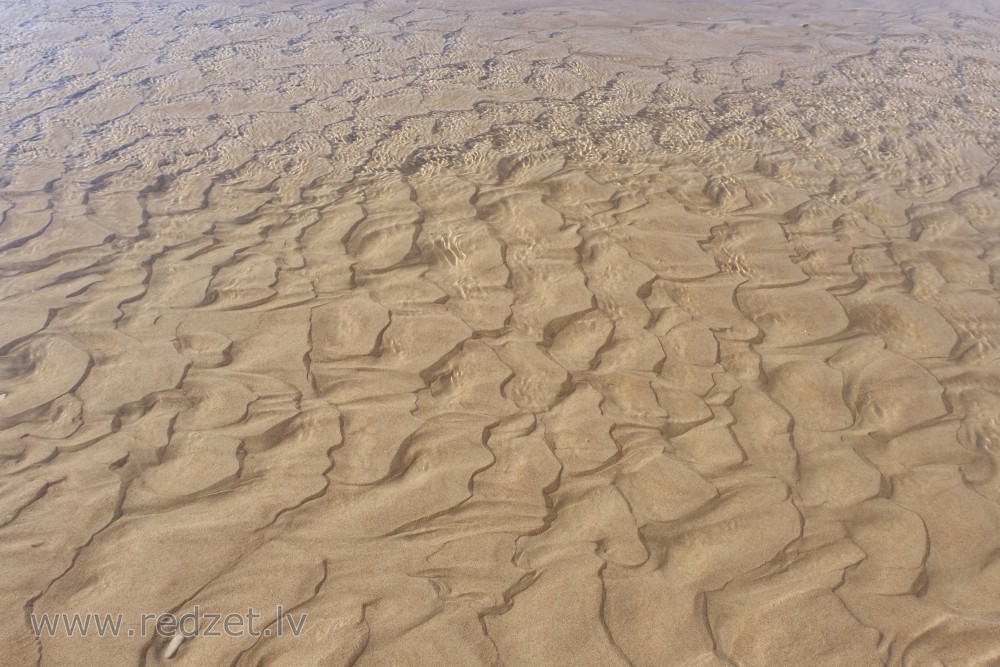Sand
Sand is a granular material composed of finely divided rock and mineral particles. It is defined by size, being finer than gravel and coarser than silt. Sand can also refer to a textural class of soil or soil type; i.e., a soil containing more than 85 percent sand-sized particles by mass.
The composition of sand varies, depending on the local rock sources and conditions, but the most common constituent of sand in inland continental settings and non-tropical coastal settings is silica (silicon dioxide, or SiO2), usually in the form of quartz. The second most common type of sand is calcium carbonate, for example, aragonite, which has mostly been created, over the past half billion years, by various forms of life, like coral and shellfish. For example, it is the primary form of sand apparent in areas where reefs have dominated the ecosystem for millions of years like the Caribbean.
Sand is a non-renewable resource over human timescales, and sand suitable for making concrete is in high demand.
Composition
The exact definition of sand varies. The scientific Unified Soil Classification System used in engineering and geology corresponds to US Standard Sieves, and defines sand as particles with a diameter of between 0.074 and 4.75 millimeters. By another definition, in terms of particle size as used by geologists, sand particles range in diameter from 0.0625 mm (or 1⁄16 mm) to 2 mm. An individual particle in this range size is termed a sand grain. Sand grains are between gravel (with particles ranging from 2 mm up to 64 mm by the latter system, and from 4.75 mm up to 75 mm in the former) and silt (particles smaller than 0.0625 mm down to 0.004 mm). The size specification between sand and gravel has remained constant for more than a century, but particle diameters as small as 0.02 mm were considered sand under the Albert Atterberg standard in use during the early 20th century. The grains of sand in Archimedes Sand Reckoner written around 240 BCE, were 0.02 mm in diameter. A 1953 engineering standard published by the American Association of State Highway and Transportation Officials set the minimum sand size at 0.074 mm. A 1938 specification of the United States Department of Agriculture was 0.05 mm. Sand feels gritty when rubbed between the fingers. Silt, by comparison, feels like flour).
ISO 14688 grades sands as fine, medium, and coarse with ranges 0.063 mm to 0.2 mm to 0.63 mm to 2.0 mm. In the United States, sand is commonly divided into five sub-categories based on size: very fine sand (1⁄16 – 1⁄8 mm diameter), fine sand (1⁄8 mm – 1⁄4 mm), medium sand (1⁄4 mm – 1⁄2 mm), coarse sand (1⁄2 mm – 1 mm), and very coarse sand (1 mm – 2 mm). These sizes are based on the Krumbein phi scale, where size in Φ = -log2D; D being the particle size in mm. On this scale, for sand the value of Φ varies from −1 to +4, with the divisions between sub-categories at whole numbers.
The most common constituent of sand, in inland continental settings and non-tropical coastal settings, is silica (silicon dioxide, or SiO2), usually in the form of quartz, which, because of its chemical inertness and considerable hardness, is the most common mineral resistant to weathering.
The composition of mineral sand is highly variable, depending on the local rock sources and conditions. The bright white sands found in tropical and subtropical coastal settings are eroded limestone and may contain coral and shell fragments in addition to other organic or organically derived fragmental material, suggesting sand formation depends on living organisms, too. The gypsum sand dunes of the White Sands National Monument in New Mexico are famous for their bright, white color. Arkose is a sand or sandstone with considerable feldspar content, derived from weathering and erosion of a (usually nearby) granitic rock outcrop. Some sands contain magnetite, chlorite, glauconite or gypsum. Sands rich in magnetite are dark to black in color, as are sands derived from volcanic basalts and obsidian. Chlorite-glauconite bearing sands are typically green in color, as are sands derived from basaltic lava with a high olivine content. Many sands, especially those found extensively in Southern Europe, have iron impurities within the quartz crystals of the sand, giving a deep yellow color. Sand deposits in some areas contain garnets and other resistant minerals, including some small gemstones.
en.wikipedia.org











